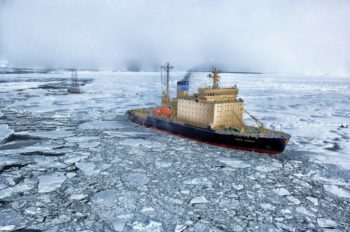
Floating ice, or sea ice, alternately called pack ice at the North and South Poles, covers 6% of the ocean’s surface (nsidc.org), an area similar to North America. The most important measure of ice is its thickness.
The United States Geologic Survey estimates the total ice on Earth weighs 28 million Gigatons (a billion tons). Antarctica and Greenland combined represent 99% of all ice on Earth.
The remaining one percent is in glaciers, ice sheets, and sea ice. Antarctica can exceed three miles in thickness and Greenland one mile.
If they were to melt sea level would indeed rise over 200 feet, but not even the most radical alarmists suggest that possibility arising due to the use of fossil fuels.
However the ice that flows off of the Antarctic and Greenland called shelf ice represents only half a percent of all the Earth’s ice and which if melted would raise sea level only 14 inches, (nsidc.com).
Although sea ice covers 6% of the entire oceans at an average thickness of six feet, were it all to melt sea level would rise only four inches.
If we melted all 200,000 of the Earth’s temperate zone glaciers sea level would rise another two feet. So total catastrophe can only occur if we can melt the Antarctic and Greenland.
But the Antarctic is the coldest place on Earth.
At www.coolantarctica.com calculations show the temperature would have to rise 54 degrees Fahrenheit to start the warming of that ice cap.
The geologic record provides a perspective on how climate impacts the quantity of ice on Earth. They have encompassed every extreme. Some 800 million years ago the planet was almost entirely encased in ice (Rafferty, J.P. Cryogenics Period).
Since then there have been many extended periods when there has been no ice present. As recently as three million years ago sea levels are believed to have been 165 feet higher than today.
While ice covered a third of the entire planet during the last ice age, when sea levels were 400 feet lower, allowing ancient peoples to cross the Siberian Land Bridge to populate North America.
Al Gore predicted in 2007 that by 2013 the Arctic Ocean would be completely ice-free. In the summer of 2012, ice levels did reach all-time lows in the Arctic.
Emboldened by this report, Australian Professor Chris Turney launched an expedition in December of 2013 to prove that the Antarctic Sea Ice was also undergoing catastrophic melting only to have his ship trapped in sea ice such that it could not even be rescued by modern ice-breakers.
The Professor should have known that a more accurate estimate of sea ice can be had from satellite images taken every day at the Poles since 1981.
These images show that between summer and winter, regardless of the degree of summer melting, the sea ice completely recovers to its original size the winter before for almost every year since the pictures were taken.
The sea ice has been stubbornly resistant to Al Gore’s predictions. In fact, the average annual coverage of sea ice has been essentially the same since satellite observations began in 1981.
However, that has not stopped global warming advocates and even government agencies from cherry picking the data to mislead the public.
Africa’s Mt. Kilimanjaro has been the poster child for land-based melting supposed to be caused by Global Warming.
It did lose half of its ice cover between 1880 and 1936 before the major use of fossil fuels and only 30% more in the past 80 years.
However, the temperature at its peak has not risen at any time during these years above freezing (32 degrees Fahrenheit).
The melting has been due to deforestation and the dry air rising to the mountain top causing the ice to turn directly into water vapor—a process called sublimation.
Melting glaciers are another topic of warming alarmists. Indeed they can choose to point to some that are actually melting, ignoring those that are growing or remaining stable.
Why the differences? They are largely dependent on whether over periods of time more snow falls than ice melts or the reverse. They are a great place to cherry pick data.
The solution to public fear about ice melting and sea level rising is simply using common sense.
Read more at CFACT
















I like how the spring thaw and sloughing glaciers is shown as proof of Global Warming by the Liberal Media. Whereas that has been happening well before the CO2 plant food concentration slightly increased.